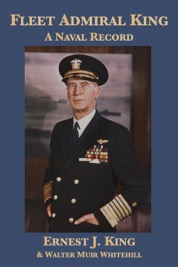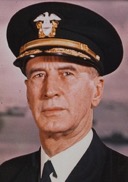
Ernest J. King and Walter Muir Whitehill
Born in Lorain, Ohio, Ernest Joseph King (1878-1956) attended the US Naval Academy at Annapolis (1897-1901), graduating fourth in his class. He served on the cruiser San Francisco in the Spanish–American War while still at the Naval Academy. After graduation, King was a junior officer on the survey ship Eagle, the battleships Illinois, Alabama and New Hampshire, and the cruiser Cincinnati. His first command was in 1914, on the destroyer Terry. During World War I, King served on the staff of Vice Admiral Henry Mayo, Commander, Atlantic Fleet. After the war, King headed the Naval Postgraduate School, commanded a submarine squadron, and the submarine base at New London. King was qualified in surface ships, submarines, and as a Naval Aviator. Starting in June 1930, he commanded the carrier Lexington for two years. Promoted to rear admiral, he ran the Bureau of Aeronautics (1933-1936). After a period on the Navy’s General Board and as Commander, Atlantic Squadron, King was promoted to admiral in February 1941 and became Commander, Atlantic Fleet. Shortly after the Japanese attack on Pearl Harbor, King was appointed Commander in Chief of the US Fleet (COMINCH). In March 1942, King succeeded Harold Stark as Chief of Naval Operations (CNO), becoming the only admiral to hold this combined command. As COMINCH-CNO, King directed the US Navy’s operations, planning and administration and was a member of the Joint Chiefs of Staff. In December 1944, King became the second admiral, after Admiral Leahy, to be made Fleet Admiral. After retiring from active duty in December 1945, King served as president of the Naval Historical Foundation (1946-1949). His autobiography appeared in 1952.
Born in Cambridge, Massachusetts, Walter Muir Whitehill (1905-1978) was a writer, historian, medievalist, and Director and Librarian of the Boston Athenaeum (1946-1973). He received his AB and MA degrees from Harvard in 1926 and 1929 and his PhD from the University of London in 1934 for his thesis on the architecture of medieval Spain. Whitehill spent World War II in the Office of Naval Records in Washington. He edited publications of the Colonial Society of Massachusetts (1946-1978) and was associated with the Peabody Museum of Archaeology and Ethnology at Harvard (1951) where he was a lecturer in history (1956-1957).
Click on the cover for details about the eBook:










